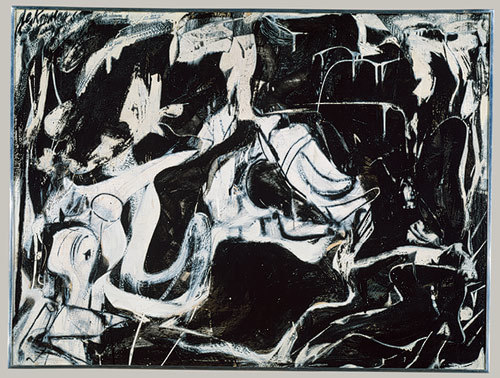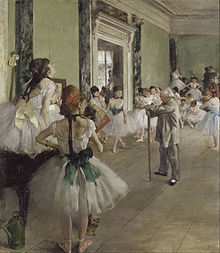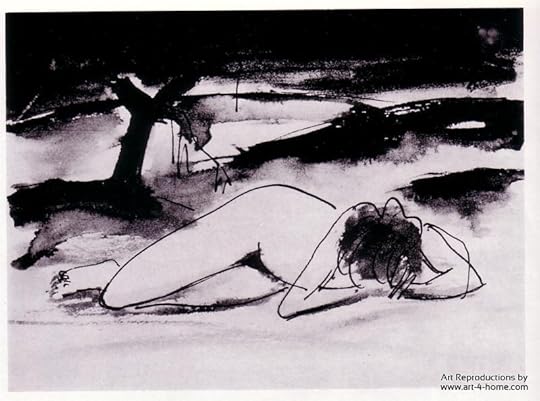Art Lovers discussion
Movements in Art
>
Action Art
date newest »
newest »
 newest »
newest »
message 1:
by
Heather
(new)
Aug 15, 2014 09:24PM
 This is a bit off the beaten path, but speaking with a friend of mine who isn't as familiar with the art world and asking him about different movements in art, he thought I meant literally. He brought up such 'movements' as martial arts, ballet, etc. What intentional movements, positions, poses, etc. would you consider art? And how has this been demonstrated in art history? Which artists portray movement or action in their art?
This is a bit off the beaten path, but speaking with a friend of mine who isn't as familiar with the art world and asking him about different movements in art, he thought I meant literally. He brought up such 'movements' as martial arts, ballet, etc. What intentional movements, positions, poses, etc. would you consider art? And how has this been demonstrated in art history? Which artists portray movement or action in their art?
reply
|
flag
Body Language is a significant aspect of modern communications and relationships.
Body Language is therefore very relevant to management and leadership,and to all aspects of work and business where communications can be seen and physically observed among people.
Body language is also very relevant to relationships outside of work,for example in dating and mating,and in families and parenting.
Communication includes listening.In terms of observable body language,non-verbal (non-spoken) signals are being exchanged whether these signals are accompanied by spoken words or not.
Body language goes both ways:
Your own body language reveals your feelings and meanings to others.
Other people's body language reveals their feelings and meanings to you.
The sending and receiving of body language signals happens on conscious and unconscious levels.
I hope this would be very helpful...
Body Language is therefore very relevant to management and leadership,and to all aspects of work and business where communications can be seen and physically observed among people.
Body language is also very relevant to relationships outside of work,for example in dating and mating,and in families and parenting.
Communication includes listening.In terms of observable body language,non-verbal (non-spoken) signals are being exchanged whether these signals are accompanied by spoken words or not.
Body language goes both ways:
Your own body language reveals your feelings and meanings to others.
Other people's body language reveals their feelings and meanings to you.
The sending and receiving of body language signals happens on conscious and unconscious levels.
I hope this would be very helpful...
 Excellent, Luis! Thank you for mentioning that. I believe sign language is the epitome of action. One can not only 'read' what is being conveyed, but the action on the person's face and the way they 'speak' shows emotion. Good point, Luis.
Excellent, Luis! Thank you for mentioning that. I believe sign language is the epitome of action. One can not only 'read' what is being conveyed, but the action on the person's face and the way they 'speak' shows emotion. Good point, Luis.
 I found a fun website actually titled Action Painting in Modern and Contemporary Art
I found a fun website actually titled Action Painting in Modern and Contemporary Arthttp://www.metmuseum.org/toah/hi/hi_m...
Some of the pieces shown include:

Night Creatures, 1965, Lee Krasner (American), Acrylic on paper (1995.595)

Black Untitled, 1948, Willem de Kooning (American, born the Netherlands), Oil and enamel on paper, mounted on wood (1984.613.7)
 Action Painting
Action PaintingTerm applied to the work of American Abstract Expressionists such as Jackson Pollock and Willem de Kooning and, by extension, to the art of their followers at home and abroad during the 1950s. An alternative but slightly more general term is gestural painting; the other division within Abstract Expressionism was colour field painting.
The critic Harold Rosenberg defined action painting in an article, ‘The American Action Painters’ (1952), where he wrote: ‘At a certain moment the canvas began to appear to one American painter after another as an arena in which to act. … What was to go on canvas was not a picture but an event’. This proposition drew heavily, and perhaps crudely, upon ideas then current in intellectual circles, especially in the wake of Jean-Paul Sartre’s essay L’Existentialisme est un humanisme (Paris, 1946; Eng. trans., 1948), which claimed that ‘there is no reality except in action’. In the 1940s Herbert Ferber, Barnett Newman and others had already characterized their creative process in similar terms; Rosenberg was probably also inspired by photographs of Pollock at work (rather than the actual paintings) that emphasized his apparent psychological freedom and physical engagement with materials. ‘Action painting’ became a common critical term to describe styles marked by impulsive brushwork, visible pentiments and unstable or energetic composition (for illustration), which seemed to express the state of consciousness held by the artist in the heat of creation. Action painting thereby shared the spontaneity of Automatism. Although this implicit, direct synthesis of art and consciousness is questionable, the spontaneous methods associated with the concept were paralleled in European movements such as Tachism and Art informel.
David Anfam
From Grove Art Online
© 2009 Oxford University Press
 Although Edgar Degas wasn't considered part of the Action Movement, I think his works show subjects of action, especially his well-known ballerinas.
Although Edgar Degas wasn't considered part of the Action Movement, I think his works show subjects of action, especially his well-known ballerinas. 
The Dance Class (La Classe de Danse), 1873–1876, oil on canvas, by Edgar Degas
 Ballet
Ballethttp://www.youtube.com/watch?v=zG2cru...
Choreography: David Dawson
Music: Max Richter
Dancers: Yumiko Takeshima and Raphael Coumes-Marquet
 Let's not forget the Kinetic artists. Sculptors like George Rickey and Jean Tinguely and Len Lye. They looked at Alexander Calder. And of course, Marcel Duchamp's Bicycle Wheel.
Let's not forget the Kinetic artists. Sculptors like George Rickey and Jean Tinguely and Len Lye. They looked at Alexander Calder. And of course, Marcel Duchamp's Bicycle Wheel. Sometimes Op Art painters are included in the discussion of Kinetic art.
However, if the work of the Abstract Expressionist had been about depicting inner turmoil and mapping an interior landscape, Kinetics pointed outward.In that way, Kinetics is part sculpture and part performance. Because these sculptures were often powered by wind and water, Kinetics relied heavily on chance. George Rickey believed that chance was natures way of effacing the hand of man!
 Gabrielle
GabrielleYears ago I had a roommate who was a performance artist. He had designed a theatrical piece with 14 actors, each of whom was instructed to carry out a singular motion on stage or among the audience. No two motions occurred simultaneously.
One actor was instructed to jump up in the air. Another would clap his hands three times. A third would shout some nonsense. The other 11 had similar nonsense roles.
He ran the motions through a computer program and then randomly reasserted their sequence by no design of his own other than a chance reassortment as per a capricious reordering on his part. I believe he might have done the reordering by a simple algebraic expression or some mathematical expression randomly chosen.
In effect, he was effacing any of his own artistic intent, which paradoxically fulfilled his intent of a perfectly random sequence of theatrical activity.
Here's some thing that might help some of you:

Franz Kline - Opustena
American Abstract Expressionist Franz Kline is best known for large black and white paintings bearing abstract motifs set down with strident confidence. He started out as a realist with a fluent style that he perfected during an academic training that encouraged him to admire Old Masters such as Rembrandt. But after settling in New York and meeting Willem de Kooning, he began to evolve his signature abstract approach. By the end of his life he had achieved immense international recognition, and his unusual approach to gestural abstraction was beginning to influence the ideas of many Minimalists.

Franz Kline - Opustena
American Abstract Expressionist Franz Kline is best known for large black and white paintings bearing abstract motifs set down with strident confidence. He started out as a realist with a fluent style that he perfected during an academic training that encouraged him to admire Old Masters such as Rembrandt. But after settling in New York and meeting Willem de Kooning, he began to evolve his signature abstract approach. By the end of his life he had achieved immense international recognition, and his unusual approach to gestural abstraction was beginning to influence the ideas of many Minimalists.
 There's some speculation that the master photographer, Aaron Susskind, colleague of Kline, actually predated the work with abstracts and Kline took the cue from him.
There's some speculation that the master photographer, Aaron Susskind, colleague of Kline, actually predated the work with abstracts and Kline took the cue from him.
 The genius behind Franz Kline isn’t in his idiotic schmiers. It is the ability of dealers to sell this garbage for mega-millions. I congratulate them.
The genius behind Franz Kline isn’t in his idiotic schmiers. It is the ability of dealers to sell this garbage for mega-millions. I congratulate them.
 Hear ye, hear ye. There's a lot of expensive crap out there. Yes, I agree with you on that score Poly. The entire bunch of first generation abstract expressionists were incredibly talented but they went over to a movement that never adequately utilised their talents. If you were to look at Jackson Pollock's earlier works from the 40's, you would see a master artist. But he went with the curatorial flow and engaged in spin art. Barnett Newman was a complete loss, however. He never had any talent. Helen F. didn't prime her canvasses, and regardless whether her work is good or not, will be worthless as the material deterioates. DeKooning is the only one worth master status, but only when he painted that mysterious woman of his earlier days.
Hear ye, hear ye. There's a lot of expensive crap out there. Yes, I agree with you on that score Poly. The entire bunch of first generation abstract expressionists were incredibly talented but they went over to a movement that never adequately utilised their talents. If you were to look at Jackson Pollock's earlier works from the 40's, you would see a master artist. But he went with the curatorial flow and engaged in spin art. Barnett Newman was a complete loss, however. He never had any talent. Helen F. didn't prime her canvasses, and regardless whether her work is good or not, will be worthless as the material deterioates. DeKooning is the only one worth master status, but only when he painted that mysterious woman of his earlier days.Now we have Carl Andre and Twombly. Arrrrrgggggghhhh. Why do we pay so much attention to these guys when there are so many other better artists out there.
 Heather wrote: "Although Edgar Degas wasn't considered part of the Action Movement, I think his works show subjects of action, especially his well-known ballerinas. The Dance Class (La Classe de Danse), 1873–187..."
Heather wrote: "Although Edgar Degas wasn't considered part of the Action Movement, I think his works show subjects of action, especially his well-known ballerinas. The Dance Class (La Classe de Danse), 1873–187..."" In 1855 he met Jean Auguste Dominique Ingres, whom Degas revered and whose advice he never forgot: "Draw lines, young man, and still more lines, both from life and from memory, and you will become a good artist."[6] In April of that year Degas was admitted to the École des Beaux-Arts. He studied drawing there with Louis Lamothe, under whose guidance he flourished, following the style of Ingres." In other words Degas, whose technical abilities were average was academically trained. He didn't really follow Ingres.
The reason Degas has such a big name is because he was associated with the impressionists and chose to reject Academic subject matter. However, better artists with far lesser modern art reputations chose much same. Degas' work is over-rated but very impressive for those whose knowledge and exposure to 19th century art doesn't go beyond the Impressionists.
 Heather wrote: "Although Edgar Degas wasn't considered part of the Action Movement, I think his works show subjects of action, especially his well-known ballerinas. The Dance Class (La Classe de Danse), 1873–187..."
Heather wrote: "Although Edgar Degas wasn't considered part of the Action Movement, I think his works show subjects of action, especially his well-known ballerinas. The Dance Class (La Classe de Danse), 1873–187..."" In 1855 he met Jean Auguste Dominique Ingres, whom Degas revered and whose advice he never forgot: "Draw lines, young man, and still more lines, both from life and from memory, and you will become a good artist."[6] In April of that year Degas was admitted to the École des Beaux-Arts. He studied drawing there with Louis Lamothe, under whose guidance he flourished, following the style of Ingres." In other words Degas, whose technical abilities were average was academically trained. He didn't really follow Ingres.
The reason Degas has such a big name is because he was associated with the impressionists and chose to reject Academic subject matter. However, better artists with far lesser modern art reputations chose much same. Degas' work is over-rated but very impressive for those whose knowledge and exposure to 19th century art doesn't go much beyond the Impressionists.


